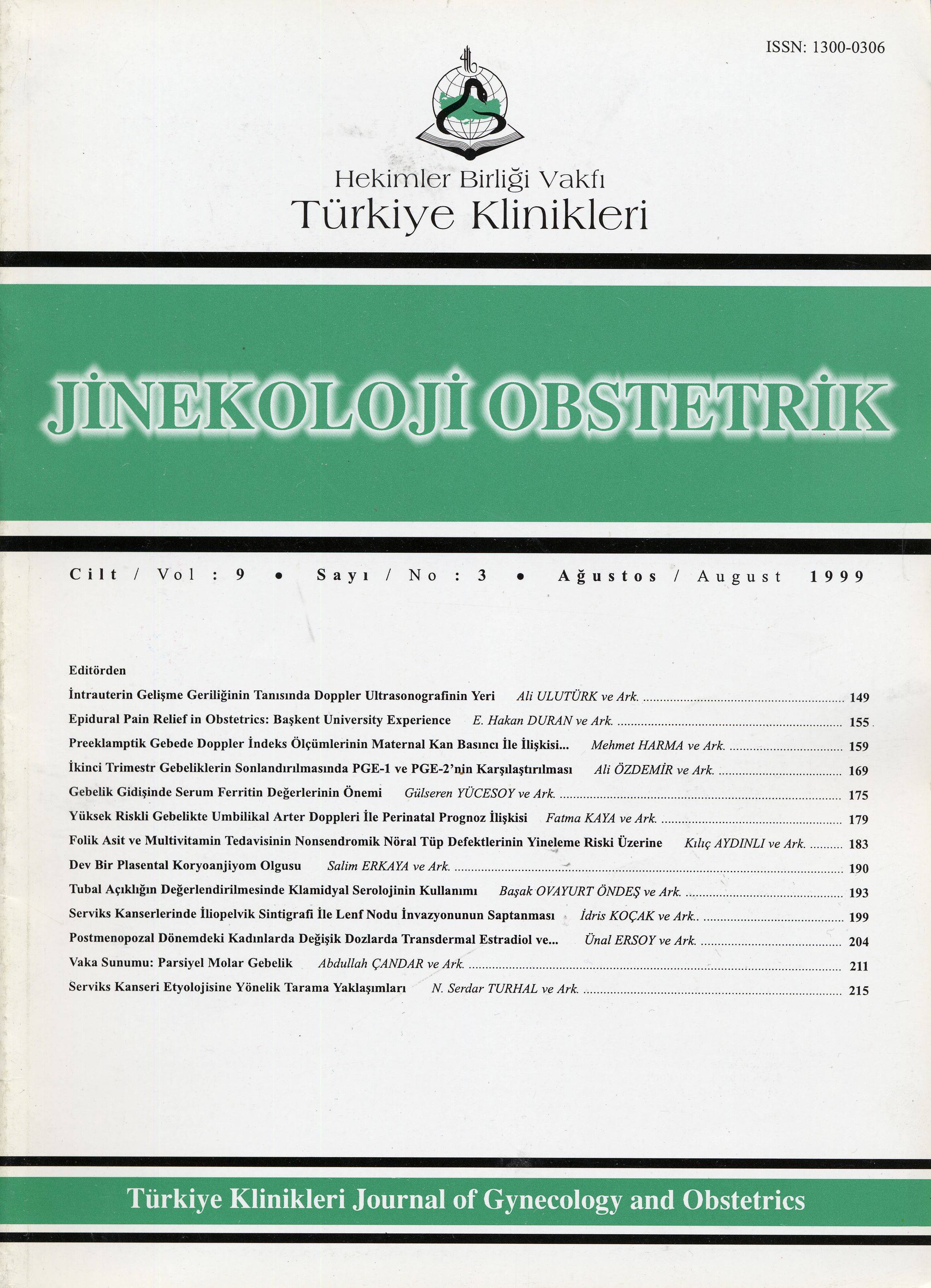Open Access
Peer Reviewed
ARTICLES
3229 Viewed1057 Downloaded
A Case Of A Giant Placental Chorioangioma
Dev Bir Plasental Koryoanjiyom Olgusu
Turkiye Klinikleri J Gynecol Obst. 1999;9(3):190-2
Article Language: TR
Copyright Ⓒ 2025 by Türkiye Klinikleri. This is an open access article under the CC BY-NC-ND license (http://creativecommons.org/licenses/by-nc-nd/4.0/)
ÖZET
Amaç: Maternal ve fetal komplikasyonlara neden olan dev bir plasental koryoanjiyom olgusunu sunmak. Çalışmanın Yapıldığı Yer: Sağlık Bakanlığı Ankara Zübeyde Hanım Doğumevi Olgu Sunumu: Prenatal takiplere gelmeyen 17 yaşında nullipar gebe aktif eylemle hastanemize başvurdu. Polihidramniyosu mevcut gebe normal vajinal doğumla doğurtuldu. Hidrops fetalisli olarak doğan bebekte konjestif kalp yetmezliği, anemi, trombositopeni mevcuttu. Plasentada ise dev bir koryoanjiyom tespit edildi. Kalp yetmezliği ve anemisi tıbbi tedavi ile düzeltilen bebekte hematemez gözlendi ve solunum arresti sonucu postpartum 42. saatte eksitus oldu. Sonuç: Koryoanjiyomlar gebeliğin erken dönemlerinde ultrasonografi ile tanınabilirler. Hem maternal hem de fetal komplikasyonlar gebeliğin erken terminasyonuna neden olabileceklerinden uygun doğum zamanını seri ultrasonografi ve fetal ekokardiyografi belirlemelidir.
Amaç: Maternal ve fetal komplikasyonlara neden olan dev bir plasental koryoanjiyom olgusunu sunmak. Çalışmanın Yapıldığı Yer: Sağlık Bakanlığı Ankara Zübeyde Hanım Doğumevi Olgu Sunumu: Prenatal takiplere gelmeyen 17 yaşında nullipar gebe aktif eylemle hastanemize başvurdu. Polihidramniyosu mevcut gebe normal vajinal doğumla doğurtuldu. Hidrops fetalisli olarak doğan bebekte konjestif kalp yetmezliği, anemi, trombositopeni mevcuttu. Plasentada ise dev bir koryoanjiyom tespit edildi. Kalp yetmezliği ve anemisi tıbbi tedavi ile düzeltilen bebekte hematemez gözlendi ve solunum arresti sonucu postpartum 42. saatte eksitus oldu. Sonuç: Koryoanjiyomlar gebeliğin erken dönemlerinde ultrasonografi ile tanınabilirler. Hem maternal hem de fetal komplikasyonlar gebeliğin erken terminasyonuna neden olabileceklerinden uygun doğum zamanını seri ultrasonografi ve fetal ekokardiyografi belirlemelidir.
ANAHTAR KELİMELER: Koryoanjiyom, Plasenta, Polihidramniyos
ABSTRACT
Objective: To present a case of a giant placental chorioangioma that caused fetal and maternal complications. Place of study: Ministry of Health, Zübeyde Hanım Doğumevi, Ankara Case presentation: A 17 years old nulliparous pregnant woman who had no prenatal follow-up was admitted to our hospital in true labor. Polyhydramnios was evident. The fetus was delivered with spontaneous vaginal birth. Hydropic child had congestive hearth failure, anemia and thrombositopenia. A giant chorioangioma was noted in the placenta. Hearth failure and anemia was managed medically. However, respiratory arrest followed hematemesis and the child was lost 42 hours after delivery. Conclusion: Chorioangiomas may be diagnosed early in pregnancy by ultrasound examination. Since both maternal and neonatal complications may indicate premature termination of the pregnancy or be conductive to premature birth, repeated ultrasonographic and fetal echocardiographic examinations should determine the optimal time of delivery.
Objective: To present a case of a giant placental chorioangioma that caused fetal and maternal complications. Place of study: Ministry of Health, Zübeyde Hanım Doğumevi, Ankara Case presentation: A 17 years old nulliparous pregnant woman who had no prenatal follow-up was admitted to our hospital in true labor. Polyhydramnios was evident. The fetus was delivered with spontaneous vaginal birth. Hydropic child had congestive hearth failure, anemia and thrombositopenia. A giant chorioangioma was noted in the placenta. Hearth failure and anemia was managed medically. However, respiratory arrest followed hematemesis and the child was lost 42 hours after delivery. Conclusion: Chorioangiomas may be diagnosed early in pregnancy by ultrasound examination. Since both maternal and neonatal complications may indicate premature termination of the pregnancy or be conductive to premature birth, repeated ultrasonographic and fetal echocardiographic examinations should determine the optimal time of delivery.
MENU
POPULAR ARTICLES
MOST DOWNLOADED ARTICLES





This journal is licensed under a Creative Commons Attribution-NonCommercial-NoDerivatives 4.0 International License.










